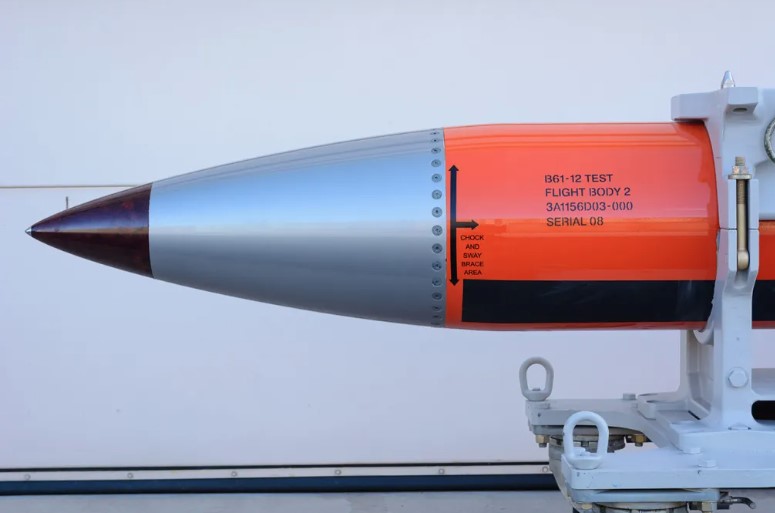On July 17, 2025, a U.S. military transport aircraft—C-17A Globemaster III, with the call sign Reach 4574—took off from Kirtland Air Force Base in New Mexico and landed at RAF Lakenheath in Suffolk, England.
A Mysterious Flight Raises Questions
The aircraft’s suspected cargo, believed to include B61-12 thermonuclear bombs, caught the attention of military trackers and aviation enthusiasts worldwide.
Kirtland Air Force Base is home to the U.S. Air Force Nuclear Weapons Center. The aircraft was designated as a high-priority mission, and a KC-46 Pegasus even provided mid-air refueling support. This type of support is not routine. Such flights are often linked to missions involving highly sensitive cargo—like nuclear weapons.
Adding to the speculation, a Notice to Airmen (NOTAM) was issued for restricted airspace over RAF Lakenheath on both July 17 and 18. Movements on the base were tightly controlled through July 26, further raising eyebrows.
Putin Rejects Use of Nuclear Weapons in Ukraine, As Drone Strikes Hit Kyiv Amid Ceasefire Talks
These facts raise the idea that B61-12 thermonuclear bombs were transported to the base, as do accounts from defense analysts. But the governments of the United States and the United Kingdom have said nothing. Additionally, NATO maintains its standard stance of neither acknowledging nor refuting the existence of nuclear weapons.
RAF Lakenheath’s B61-12 Bomb Legacy and Modernization
RAF Lakenheath is no stranger to nuclear weapons. During the Cold War, the location housed up to 110 B61 bombs in underground vaults called the Weapons Storage and Security System (WS3) from 1954 until 2008. These bombs were kept in 33 vaults and used by American F-15E Strike Eagle aircraft.
All nuclear weapons were taken out of the base in 2008 as part of NATO’s post-Cold War security posture change. For the first time in decades, there were no American nukes on British soil.
But things have been changing. In 2022, the U.S. Department of Defense started upgrading the WS3 vaults at RAF Lakenheath. Budget documents showed funding for a “surety dormitory,” which is a term linked with nuclear missions.
United States Imposes Sanctions on China-Iran Tech Network Supplying Nuclear Weapon Machinery
The UK declared in June 2025 that it would purchase 12 F-35A combat fighters. The B61-12 nuclear bombs can be carried by these approved aircraft. Additionally, Britain declared its intention to re-join NATO’s nuclear sharing program. In accordance with NATO’s intentions, this would enable American nuclear weapons to be stored in the UK once more and possibly employed by UK soldiers.
Now that F-35A planes have arrived and base improvements are continuing, RAF Lakenheath is once again in the news.
Why the B61-12 Bomb Is NATO’s New Tactical Weapon
The B61-12 is not just another nuclear bomb. It is one of the most advanced in the world. Designed as part of NATO’s modern deterrent system, it replaces older versions like the B61-3 and B61-4.
The changeable yield of the B61-12 is one of its most notable characteristics. Therefore, it is possible to select the explosive power between 0.3 and 50 kilotons.In contrast, the bomb unleashed on Hiroshima in 1945 contained about 15 kilotons.
The B61-12 is the only aircraft with the Boeing-designed tail kit. Through the use of an inertial navigation system, this tail kit provides the bomb with pinpoint accuracy. The B61-12 can be dropped from a distance, which makes it safer for the pilot and the aircraft than older bombs.
Stealth aircraft such as the F-35A Lightning II, now based at RAF Lakenheath, can also use it. This pairing allows NATO forces to deliver nuclear weapons with precision and minimal risk.
New Cold War? U.S. Faces Expanding Nuclear Rivalries
The bomb is built with enhanced safety systems, including “insensitive high explosives” that reduce the risk of accidental detonation. It also includes advanced digital interfaces, making it ideal for use with modern aircraft and systems.
The B61-12 can even penetrate underground targets. A 2016 video released by Sandia National Laboratories showed the bomb burrowing deep into the Nevada desert before detonation. This makes it useful for destroying underground bunkers or fortified military positions.
Though it doesn’t have the long range of Russia’s Iskander missile, which can fly up to 500 kilometers, the B61-12 makes up for it with precision. Combined with the F-35A’s combat radius of 1,200 kilometers, NATO gains a strategic advantage in reaching critical targets.
